
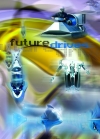
Nature, where one finds the most complex machines, is the inspiration for Festo's new Bionic Learning Network drives. Festo's leading edge technology, combined with nature's blueprint, forms the basis of the new drives showcased at this year's Hannover Fair in Germany.
Robot fish
The Airacuda is a remote controlled, pneumatically driven fish that glides silently and gracefully through water. The construction and design of the Airacuda closely mirrors the lines and motions of its biological counterpart.
The brain of the Airacuda is located in the watertight head that houses the electronics and pneumatics which control the s-shaped motion of the tail fin which is accomplished using two fluidic muscles. Steering is facilitated by two additional muscles.
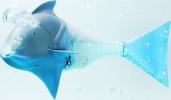
The fin itself contains an alternating tension/compression flank connected to a rib structure. When a flank is pressurised, the geometric structure arches against the acting force. This simple principle enables a fish to utilise the full power of its fin stroke in water. The structure is called the 'Fin Ray Effect' and is used in two ways: firstly, as a passive component of the tail fin and secondly as an active structure in the body. The diagonals in the structure are shortened alternately with the aid of fluidic muscles.
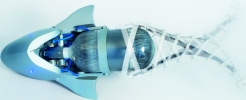
In practical applications, fin drives have numerous advantages over conventional propellers. A greater proportion of the motion is converted into thrust and in contrast to conventional drives used in water, the fish does not need a rigid drive unit.
Fluidic muscle
The fluidic muscle is a Festo innovation. Its dynamics are similar to those of a real muscle, yet it is operated with compressed air. The initial force of this artificial muscle is extremely high and its dynamics resemble those of biological muscle. With its low weight, high flexibility and wide variety of uses, it is well suited to bionic applications.
Humanoid robot
The Humanoid muscle robot, a joint project between EvoLogics GmbH and the Bionics and Evolution Technology department of the Technical University of Berlin, uses the Festo fluidic muscles in a completely different manner. The project has evolved from a functional study of a simple robot arm in 2000 to a fully developed torso and two anthropomorphic arms and five-fingered hands.
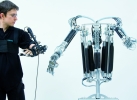
The key element for the technical realisation of the project was the supply of the Festo fluidic muscles, whose tensile force can be smoothly transferred by artificial sinews made of extremely tough Dyneema fibres and via numerous joints to the desired actuators. This allows the actuators to be placed favourably in the body and keeps the mass of moving parts to a minimum. Two each of these powerful and ultra-light actuators can be switched together as an antagonistic muscle pair and also serve as energy accumulators, enabling flowing and elastic motions. Elementary functions - such as bending, stretching and turning - mean that highly complex motions can be realised within the overall context of the construction, with a total of 48° of freedom.
The Humanoid has almost the same radius of action as a similar-size person. With its favourable weight-to-power ratio, its ability to grasp objects and position them within its sphere of motion and its manlike proportions, the Humanoid leaves no doubt as to its role model. The robot can either follow pre-programmed motions or be controlled online via data suit and data glove. This enables all movements of the human protagonist to be transferred directly to the robot with a delay of around half a second - even over great distances. This means that man's bionic stand-in can be used in places which are either inaccessible or too dangerous for humans. The range of potential applications stretches from terrestrial environments to the ocean to jobs in outer space.
Ion drive
The b-IONIC Airfish was also showcased in Hannover. This unique technological test bed combines sophisticated bionics in the form of a streamlined penguin design, with an unusual propulsion system, the ion drive.

Ion drives were originally conceived for applications in space and work with high direct-current voltages. The thrust generated in space is very small - in the millinewton range. But in a vacuum, this constant acceleration of ions is sufficient to allow the vehicle to gradually reach high speeds over long interplanetary distances. In the case of Airfish, in the atmosphere, the same principle can be used to accelerate ionised air and generate a small amount of thrust for this lighter than air flying model.
The ion drive is located in the swivel-mounted tail wings, operates almost silently and without moving parts and makes the aircraft completely manoeuvrable. The flat-formed air acceleration unit mounted along the wing replaces the mechanical flapping wing propulsion system of penguins and provides forward thrust for the b-IONIC Airfish.
However, the main future applications for atmospheric ion drives are not so much in the field of forward thrust but focus rather on reducing or eliminating drag. Flow phenomena also play a major role in valve technology. Following the realisation of an Airfish using pneumatic structures and bionic propeller drives, the current test model continues to examine the topic of drag manipulation by using an ion drive on the surface. The ion wind creates a targeted reduction in surface friction. This enables the b-IONIC Airfish of the future to swim through air.
Hovercraft with thrust vector control
Another innovative use of pneumatics is found in the Festo sponsored Hovercraft Vector project. The Hovercraft with thrust vector control is a prime example of highly accurate manoeuvring capabilities on land and water.
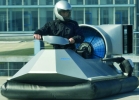
The thrust control system, developed in co-operation with students of the Bielefeld University of Applied Sciences, uses a steering principle similar to that of a track vehicle. The air flow created by the propeller is divided into two channels. Each of these channels has a pair of shutters, which work in a similar way to the reverse thrust system of a turbo propulsion unit and can regulate the proportion of air expelled in the forward or backward direction. This makes braking and manoeuvring in reverse as easy as when going forward.
Festo's performance at the Hannover Fair underscores its ability to capitalise on refined designs found in nature and combining them with its significant pneumatic capabilities in order to provide customers with leading edge technology solutions for most any application.
For more information contact Joanne Dix, Festo, +27 (0) 11 971 5560, [email protected]
| Email: | [email protected] |
| www: | www.festo.co.za |
| Articles: | More information and articles about Festo South Africa |

© Technews Publishing (Pty) Ltd | All Rights Reserved